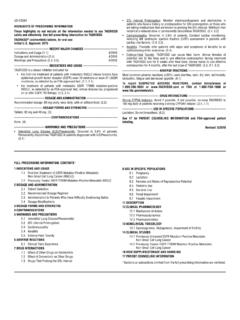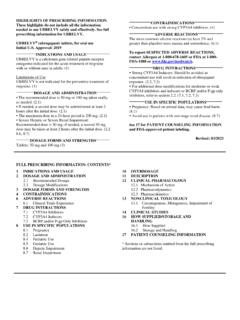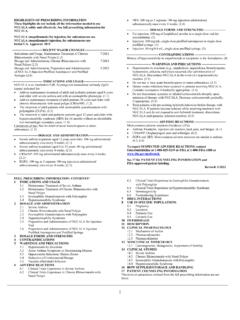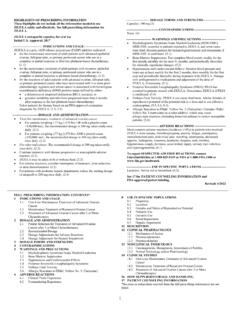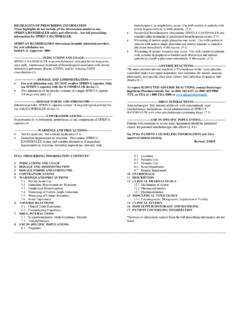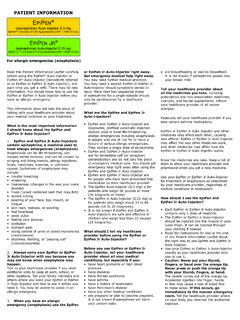Transcription of FDA-Approved Patient Labeling NEXPLANON (etonogestrel ...
1 1 FDA-Approved Patient Labeling NEXPLANON (etonogestrel implant) Radiopaque Subdermal Use Only NEXPLANON does not protect against HIV infection (the virus that causes AIDS) or other sexually transmitted diseases. Read this Patient information leaflet carefully before you decide if NEXPLANON is right for you. This information does not take the place of talking with your healthcare provider. If you have any questions about NEXPLANON , ask your healthcare provider. What is NEXPLANON ? NEXPLANON is a hormone-releasing birth control implant for use by women to prevent pregnancy for up to 3 years. The implant is a flexible plastic rod about the size of a matchstick that contains a progestin hormone called etonogestrel.
2 It contains a small amount of barium sulfate (15 mg), so that the implant can be seen by X-ray, an ethylene vinyl acetate (EVA) copolymer (28% vinyl acetate, 43 mg) core, and magnesium stearate ( mg). Your healthcare provider will insert the implant just under the skin of the inner side of your upper arm. You can use a single NEXPLANON implant for up to 3 years. NEXPLANON does not contain estrogen. What if I need birth control for more than 3 years? The NEXPLANON implant must be removed after 3 years. Your healthcare provider can insert a new implant under your skin after taking out the old one if you choose to continue using NEXPLANON for birth control.
3 What if I change my mind about birth control and want to stop using NEXPLANON before 3 years? Your healthcare provider can remove the implant at any time. You may become pregnant as early as the first week after removal of the implant. If you do not want to get pregnant after your healthcare provider removes the NEXPLANON implant, you should start another birth control method right away. How does NEXPLANON work? NEXPLANON prevents pregnancy in several ways. The most important way is by stopping the release of an egg from your ovary. NEXPLANON also thickens the mucus in your cervix and this change may keep sperm from reaching the egg.
4 NEXPLANON also changes the lining of your uterus. How well does NEXPLANON work? When the NEXPLANON implant is placed correctly, your chance of getting pregnant is very low (less than 1 pregnancy per 100 women who use NEXPLANON for 1 year). It is not known if NEXPLANON is as effective in very overweight women because studies did not include many overweight women. The following chart shows the chance of getting pregnant for women who use different methods of birth control. Each box on the chart contains a list of birth control methods that are similar in effectiveness. The most effective methods are at the top of the chart.
5 The box on the bottom of the chart shows the chance of getting pregnant for women who do not use birth control and are trying to get pregnant. 2 Fewer than 1 pregnancy per 100 women in one year Fewer Pregnancies Implants Injections Intrauterine devices Sterilization Birth control pills Skin patch Vaginal ring with hormones 10-20 pregnancies per 100 women in one year Condoms Diaphragm No sex during the most fertile days of the monthly cycle Spermicide Withdrawal 85 or more pregnancies per 100 women in one year More Pregnancies No birth control Who should not use NEXPLANON ?
6 Do not use NEXPLANON if you: Are pregnant or think you may be pregnant Have, or have had blood clots, such as blood clots in your legs (deep venous thrombosis), lungs (pulmonary embolism), eyes (total or partial blindness), heart (heart attack), or brain (stroke) Have liver disease or a liver tumor Have unexplained vaginal bleeding Have breast cancer or any other cancer that is sensitive to progestin (a female hormone), now or in the past Are allergic to anything in NEXPLANON Tell your healthcare provider if you have or have had any of the conditions listed above. Your healthcare provider can suggest a different method of birth control.
7 In addition, talk to your healthcare provider about using NEXPLANON if you: Have diabetes Have high cholesterol or triglycerides Have headaches Have gallbladder or kidney problems Have a history of depressed mood Have high blood pressure Have an allergy to numbing medicines (anesthetics) or medicines used to clean your skin (antiseptics). These medicines will be used when the implant is placed into or removed from your arm. 3 Interaction with Other Medicines Tell your healthcare provider about all the medicines you take, including prescription and non-prescription medicines, vitamins and herbal supplements.
8 Certain medicines may make NEXPLANON less effective, including: aprepitant barbiturates bosentan carbamazepine felbamate griseofulvin oxcarbazepine phenytoin rifampin St. John's wort topiramate HIV medicines Hepatitis C Virus medicines Ask your healthcare provider if you are not sure if your medicine is one listed above. If you are taking medicines or herbal products that might make NEXPLANON less effective, you and your healthcare provider may decide to leave NEXPLANON in place; in that case, an additional non-hormonal contraceptive should be used. Because the effect of another medicine on NEXPLANON may last up to 28 days after stopping the medicine, it is necessary to use the additional non-hormonal contraceptive for that long.
9 When you are using NEXPLANON , tell all of your healthcare providers that you have NEXPLANON in place in your arm. How is the NEXPLANON implant placed and removed? Your healthcare provider will place and remove the NEXPLANON implant in a minor surgical procedure in his or her office. The implant is placed just under the skin on the inner side of your non-dominant upper arm. The timing of insertion is important. Your healthcare provider may: Perform a pregnancy test before inserting NEXPLANON Schedule the insertion at a specific time of your menstrual cycle (for example, within the first 5 days of your regular menstrual bleeding).
10 If the implant is placed after the fifth day of menses, then you should use an additional contraceptive method (such as a condom) for the first 7 days after insertion. Your healthcare provider will cover the site where NEXPLANON was placed with 2 bandages. Leave the top bandage on for 24 hours. Keep the smaller bandage clean, dry, and in place for 3 to 5 days. Immediately after the NEXPLANON implant has been placed, you and your healthcare provider should check that the implant is in your arm by feeling for it. If you cannot feel the implant immediately after insertion, the implant may not have been inserted, or it may have been inserted deeply.




